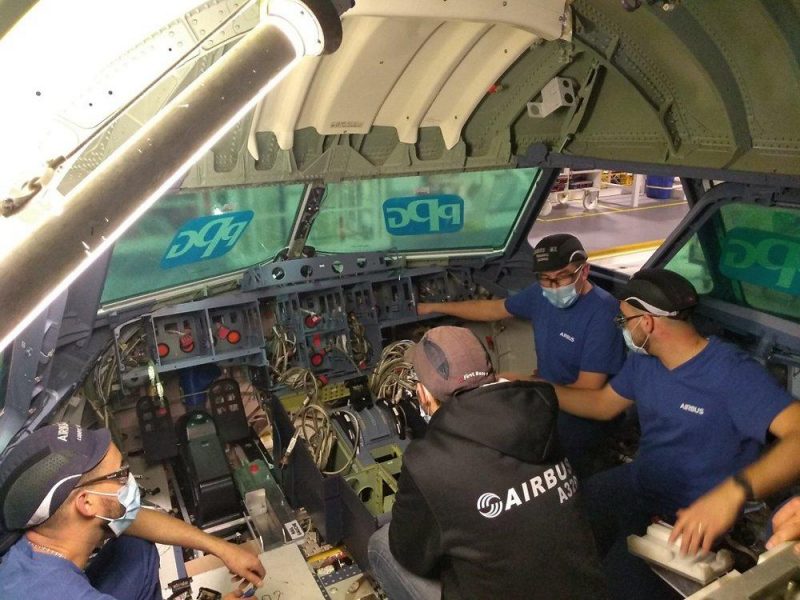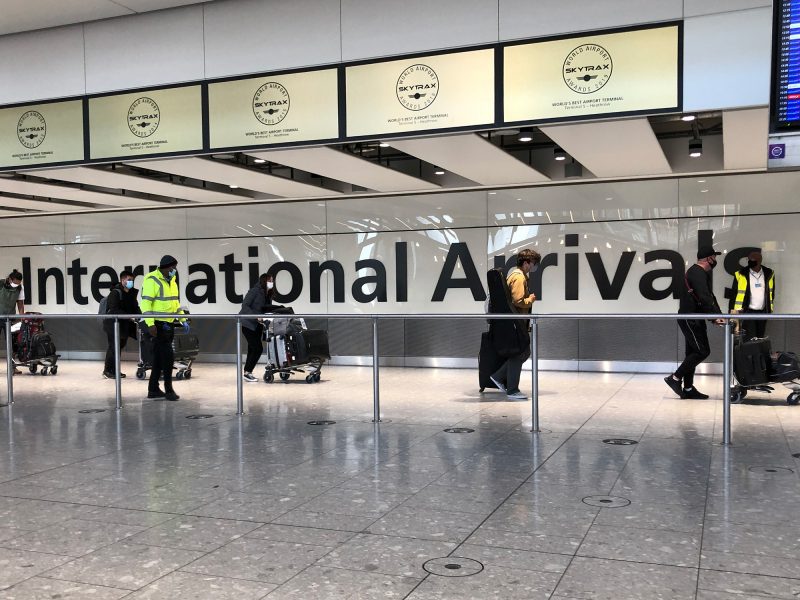A321 XLR to start test flights soon | Completes final structural assembly
Prashant-prabhakar
09 Dec 2021

Airbus has completed the final structural assembly of the highly hyped, long-range narrowbody, the A321 XLR (Extra Long Range).
The aircraft, with serial number MSN11000, is one of the three planned development aircraft which will perform the flight testing and Type Certification programme -- starting in 2022, to pave the way for series production and entry into service in 2023.
Aviation International News
While other Final Assembly Line (FAL) locations would be eventually producing the A321 XLR, Airbus chose Hamburg to pilot’ this new variant into series production. The structural completion follows the recent assembly and equipping of the Major Component Assemblies (MCAs) and their subsequent delivery and introduction on schedule into the FAL in November.
For the A321 Family, we have started all the head-of-versions in Hamburg -- the real first ones -- and it is our intention to build these aircraft also at the other sites Michael Menking, Head of the A320 Family Programme
Of the four A320 Family assembly lines in Hamburg, the one which is processing the first A321XLR is referred to as “FAL Line 2". The subsequent two A321XLR development aircraft – MSN11058 and MSN11080 – will follow in due course from the same assembly line.
We are currently on the way to also have the A321XLR delivered out of other Single Aisle FALs. So it is important for sure that all the teams learn from the experience in Hamburg so we can bring this knowledge to the other facilities. This is also what we are doing with the A320 Family Airspace cabin which we started in HamburgMichael Menking
After having passed through all the stations, the very first A321XLR will have transformed from a collection of individual parts into a real aircraft.
This test aircraft has a partial cabin installed to leave space for all the required flight test equipment. What is also specific for this first A321XLR aircraft is that there is a lot of documentation work to be done, especially for flight test installation, which is very different from our serial process. So this requires a special focus by all the teams in closing the documentation and dealing with any discrepanciesGerd Weber, Head of A320 Family Value Stream Management & FALs
The aircraft will eventually have a sophisticated flight-test-instrumentation (FTI) suite installed followed by the installation of its CFM LEAP engines.
With all that in place and the aircraft’s external paint scheme implemented, the aircraft would be ready to perform the taxiing runs and eventually its maiden test flight, tentatively by next year.
The A321 XLR, which is basically a variant of the A321 LR, was launched at the June 2019 Paris Air Show, with a 4,700 nmi range.
Additionally, it also features a new permanent Rear Centre Tank (RCT) for more fuel, strengthened landing gear for a 101 t (223,000 lb) MTOW and an optimised wing trailing-edge flap configuration to preserve take-off performance.
A321 XLR REAR CENTRE TANK (RCT) | SimpleFlying
Did you know? The A321 XLR offers a vast 4,700 nautical miles of range, exceeding any current narrowbodies at the moment. In comparison, the longest-range Boeing 737 MAX 7, offers a range of 3,850 NM (but only seats up to 150), while the A321LR has a range of 4,000 NM (seats 206 passengers).
AIRBUS
The extra-long range of the A321 XLR would allow low-cost carriers to tap into long haul markets which were earlier dominated by widebodies. Not surprisingly, Indigo broke news last October by placing an order for a massive 300 A320 Neo family aircraft which included the A321 XLR as well.
SOURCE: Airbus
COVER: Airbus
Read next
50% Indians want government to halt international flights from countries with 20+ Omicron cases
Radhika Bansal
07 Dec 2021

As the country records over 20 cases of Omicron in just three days while several COVID-19-positive samples undergo genome testing, as many as 50% of people want the central government to suspend all Vande Bharat flights coming from countries where 20 or more Omicron cases have been detected, according to a survey.
The survey was done by the online platform LocalCircles and received over 18,000 responses from citizens residing in 317 districts of the country.
It was conducted to understand the approach that people want the government to take on international flight restrictions and also to strengthen the quarantine process so that the risk of Omicron spread is minimised, according to a statement.
(Image Courtesy - Outlook India)
The government has identified 14 countries as “at-risk” countries, including South Africa, Botswana, Zimbabwe as well as European countries like the UK and Singapore.
The people were also asked if it should be made mandatory for district health officials to do inspection or location tracking for anyone undergoing home quarantine. In response, only 16% said it was not required and 84% said it should be made mandatory, indicating that the majority wants district officials to regularly inspect or location track individuals coming on international flights and under home quarantine to minimise the risk of Omicron variant. The question in the survey received 8,590 responses.
People want the government to streamline the home quarantine process by effectively tracking and tracing these individuals such that the risk of Omicron spread through them is reduced, it said. The scheduled commercial international passenger flight services to and from India remain suspended for nearly 21 months now due to the pandemic.
(Image Courtesy - The Economic Times)
To facilitate international air travel, the government has allowed operations of flight services in a limited manner under the Vande Bharat Mission and air bubble pacts with various governments. Currently, India has air bubble agreements with as many as 31 countries from Afghanistan and Bangladesh to Canada, France, Germany, Japan, Singapore, the UAE, the UK and the US, among others.
Reports from several states suggest that international travellers have either become non-traceable after exiting from the airport or allegedly deliberately given the wrong contact information about themselves, it said. The risk is that if these travellers start going out, meeting others and visiting tourist destinations, they are likely to infect many more, LocalCircles said in the release.
“The need of the hour, according to the people, is for the government to ensure that a traveller arriving from an ‘at-risk’ country must validate their phone number or e-mail address to be approved for home quarantine via an OTP and if the same does not happen, the traveller should be put in mandatory institutional quarantine."Sachin Taparia, Founder, LocalCircles
People also suggested that location tracking of the travellers must be done via WhatsApp or Arogya Setu or some other mechanism such that they maintain the home quarantine discipline, Taparia added.
Also, the transfer of information of travellers sent by airport authorities to the district administration must be done in real-time, said LocalCircles. It added that the findings in the survey indicate that people want timely action on these two recommendations, helpful in isolating Omicron cases and slowing their spread and possibly averting the third wave.
The survey received more than 18,000 responses from citizens residing in 317 districts of India. 68% of respondents were men while 32% of respondents were women.
The variant, which has scientists and epidemiologists from around the world raise red flags, has been categorised as a “variant of concern” by the World Health Organisation after it was identified in three countries. Within a week, Omicron has been detected in over 50 countries with all major countries included. The latest data suggests that the Omicron variant has between 30-50 mutations and a 5X transmission advantage over the base or alpha variant of SARS-CoV-2. More data is awaited on the severity of illness caused by Omicron, along with the efficacy of existing vaccines against this variant.
(With Inputs from PTI)
Cover Image - Bloomberg
Read next
The airlines and airports in India incurred an estimated loss of INR 19,564 crore and INR 5,116 crore, respectively, in 2020-21 due to severe disruption caused by the COVID-19 pandemic, Minister of State for Civil Aviation V K Singh said on Monday, December 6.
Domestic flight operations were suspended due to the outbreak of the Covid-19 pandemic for about two months from 25 March 2020. Operations were resumed in a calibrated manner, with capacity restrictions and fare caps imposed on airlines. Capacity restrictions were, however, removed on 18 October with the revival of air passenger traffic.
However, since June 2020, the government allowed limited operations of Air India flights under the “Vande Bharat” mission for certain categories like Overseas Citizenship of India, Persons of Indian Origin card-holders and other Indians who have stuck abroad due to the pandemic.
"The aviation sector in India has been affected due to severe disruption caused by the COVID-19 pandemic," the minister said in his written reply to a question in the Rajya Sabha."
The estimated losses incurred by airlines and airports in India in the financial year 2020-21 is approximately INR 19,564 crore and INR 5,116 crore respectively," he mentioned.
Despite a ?revival in domestic traffic in the recent months, Indian airlines are expected to incur losses worth $3.5-4 billion, excluding any adjustments, in this financial year (FY 2022), aviation consultancy firm CAPA India said in a recent report.
Aviation has been one of the worst affected sectors due to the coronavirus pandemic. Multiple airlines resorted to salary cuts and layoffs last year to deal with losses.
Read next
Transatlantic hydrogen-powered travel on the cards? It might be closer than we think
Prashant-prabhakar
07 Dec 2021

A breakthrough in hydrogen propulsion for long-range air travel may well be on the horizon. And it might be closer to implementation than we previously thought.
Led by the ATI (Aerospace Technology Institute) and backed by the UK Government, FlyZero is setting out to realise zero-carbon emission air travel by the end of the decade.
Aerospace Technology Institute
Reportedly, the research group has unveiled what is dubbed as "FlyZero"- a design for a liquid hydrogen-powered airliner, touted to replicate the performance of modern mid-size airliners sans the carbon emissions.
The FlyZero concept envisions a plane carrying 279 passengers non-stop from London to San Francisco at the same speed and comfort as todaythe Aerospace Technology Institute said in a statement Monday
Tech and specifications
The design unveiled on Monday would store hydrogen at minus 250 degrees Celsius in cryogenic fuel tanks at the rear of the plane and in two smaller “cheek” tanks along the forward fuselage to keep the aircraft balanced.
Powered by two turbofans, the midsize model has a wingspan of 54 metres.
Before the pandemic grounded most flights, commercial aviation accounted for about 2.5% of global emissions of carbon dioxide. Various studies and experiments have brought hydrogen and electrical propulsion to the fore. More importantly, in the context of aviation, hydrogen seems to pack more energy per unit of mass.
With improved engines and technology, carbon dioxide emissions per passenger flight have fallen more than 50% since 1990. However, bringing hydrogen into the picture has its share of downsides too. In comparison to using jet fuel, hydrogen is more expensive. The task of storing it on-board and the additional hassle(s) of building appropriate infrastructure at airports like refuelling facilities, add to the challenges further.
The UK based research firm expects the aircraft to enter service, probably by mid-2030.
Furthermore, the group plans to publish detailed concepts for regional, narrow-body and midsize aircraft, with technology roadmaps, market and economic reports and a sustainability assessment by early next year.
https://www.youtube.com/watch?v=LUUPAwa4kOQ&t=37s
Project Director, Chris Gear, shares the FlyZero vision to realise zero carbon emission commercial aviation by the end of the decade.
Did you know? The record for the fastest transatlantic flight by a commercial airline between New York and London is two hours, 52 minutes and 59 seconds - set by Concorde in 1996. The Concorde was eventually retired from service in October 2003 after British Airways and Air France blamed a downturn in demand and increasing maintenance costs.
COVER: CNBC
Read next
Air India and SpiceJet owes INR 2350 crore and INR 185 crore respectively to AAI
Radhika Bansal
07 Dec 2021
Air India and SpiceJet have outstanding dues of INR 2,350 crore and INR 185 crore respectively to the Airports Authority of India (AAI) as of September this year, Minister of State for Civil Aviation V K Singh said on Monday, December 6.
"Some airlines have defaulted on clearance of their dues," Singh said in a written response to a question in Rajya Sabha.
The AAI follows up with the airlines regularly for recovery of dues according to its credit policy, he mentioned.
Charging penal interest, encashment of security deposits along resorting to legal action were other measures available with the AAI to carry out the recovery of dues, he noted.
The AAI owns 125-odd airports across the country. Airlines have to regularly pay various charges such as landing charges and parking charges to the AAI to operate aircraft from its airports.
The minister said the outstanding dues of Air India, Alliance Air, SpiceJet and Go Air (now called Go First) up to September 2021 was INR 2,350 crore, INR 109 crore, INR 185 crore and INR 56 crore, respectively.
Separately, Government departments and autonomous bodies have dues of more than INR 244 crore to Air India, of which a little over INR 30 crore has been recovered, the government also mentioned in Parliament on Monday, December 6.
He was responding to a set of questions raised by several MPs regarding the sale of Air India to Tata group.
"Government departments/autonomous bodies owe Air India INR 244.78 crore as of September 30, 2021. Out of this, INR 30.38 crore has been recovered as of November 30, 2021.There was a huge accumulated debt on Air India, following which the government took an enterprise value (EV) bidding approach for strategic divestment of Air India and its identified subsidiaries and joint ventures.The strategic disinvestment transaction has been carried out for the entire company as a going concern. Assets other than non-core assets and liabilities other than those excluded from the transaction will remain with the acquirer.Non-core assets of Air India and its subsidiaries (book value of INR 14,718 crore as on August 31, 2021) are not a part of the disinvestment transaction and will not be taken over by the successful bidder but transferred to Air India Asset Holding Company (AIAHL), 100% owned by GoI."Bhagwat Karad, Minister of State for Finance
A share purchase agreement (SPA) was signed on October 25, 2021, setting up precedent conditions to be fulfilled by the bidder (Tata group), Air India and the government before closing the transaction.
Among others, Karad said the employees of Air India cannot be retrenched for one year from the closing date.
They will be eligible for a voluntary retirement scheme with maximum benefits in case of retrenchment in the second year from closing, he added.
Read next
Average fares on air bubble flights for AI, United & Lufthansa are comparable to pre-pandemic levels
Radhika Bansal
07 Dec 2021

Average economy class fares on flights of Air India, United Airlines and Lufthansa, operating under the 'air bubble' arrangement currently, are comparable to the average fares of the pre-pandemic era, Minister of State for Civil Aviation V K Singh said on Monday, December 6.
Scheduled international passenger flights have been suspended in India since March 23, 2020, when the coronavirus pandemic had started spreading across the world.
"As per details of fare submitted by Air India (the only Indian carrier operating to Europe and North America), United Airlines (operating between India and USA) and Lufthansa (operating between India and Germany), average fares for travel by economy class, under the air travel bubble arrangements, are comparable to the average fares during winter 2019 schedule (pre-Covid)."Gen (Retd.) V.K. SIngh, Minister of State for Civil Aviation
However, since July 2020, India has formed bilateral air bubble arrangements with around 31 countries so that special international passenger flights -- with certain restrictions -- could be operated.
The Centre had on December 1 decided not to resume scheduled international flights from December 15, less than a week after announcing the decision in the wake of rising concerns over the COVID variant Omicron.
On the matter of resumption of scheduled international flights, Singh said: "Because of the evolving global scenario with the emergence of new variants of concern, the situation is being closely monitored and reviewed in consultation with other ministries, concerning taking any further decision on this issue."
India has also sent the proposal to Saudi Arabia and nine other countries for operating flights under the air bubble agreement, the government told Lok Sabha on December 2.


Comment